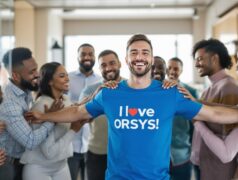Search engine optimisation is the cornerstone of a successful digital presence. This discipline revolves around several strategic levers: SEO for sustainable positioning, SEA for immediate results and SMO for social media outreach. Mastering these different areas is essential for maximising your online visibility and standing out from the increasingly fierce competition on the web. Pauline Bonnet, web and SEO project manager, details the strategies to adopt..

SEM: a global, integrated strategy
Definition and scope of SEM
SEM (search engine marketing) refers to the whole range of search engine marketing activities. strategies and techniques used for increase visibility of a website on search engines like Google.
The power of SEM lies in its ability to orchestrate several acquisition channels simultaneously.
This global approach maximises the impact of marketing campaigns by combining natural search engine optimisation and targeted advertising.
Quality traffic is built up through a well-balanced SEM strategy.
For example, an e-commerce business can use SEO to generate organic visits to its product pages, while SEA (paid visits) targets specific keywords during promotional periods.
Precise performance measurement is a major advantage of SEM. Analysis tools can be used to optimise the return on investment (ROI) by rapidly adjusting budgets between the various levers according to their effectiveness.
Is SEM still relevant?
The emergence of social platforms is radically transforming the approach to SEM. Brands are adapting their strategies to integrate TikTok, Instagram Shopping or LinkedIn into their digital marketing mix. This is in response to the new multi-platform behaviour of consumers.
Changing practices as new platforms and tools take off
The automation tools are also revolutionising SEM practices. Artificial intelligence optimises campaigns in real time, analyses behavioural data and refines targeting. For example, solutions such as Semrush or Ahrefs now offer predictive features to anticipate search trends.
Read also
The advent of social commerce and voice search is also forcing professionals to rethink their tactics. Queries are becoming more conversational, requiring constant adaptation of keywords and content.
Imagine a user looking for information on a specific subject, such as indoor gardening. Initially, a simple search might be "indoor gardening". However, over time, users start to ask more specific and natural questions, such as "How do I plant tomatoes in my living room?" or "What's the best lighting for my indoor plants?". These queries are becoming more conversational. This is forcing search engines or AI systems to adjust their algorithms, keywords and responses to adapt to this evolution in language.
Natural search engine optimisation (SEO): an essential pillar
Definition and objectives of SEO (Google search engine optimisation)
SEO is the art of optimising a website for search engines. This discipline is based on natural techniques designed to improve the visibility of a web page in the organic results of Google and other search engines.
La referencing strategy is pursuing two major objectives:
- attract qualified traffic
- convert visitors into customers
For example, an e-commerce company selling luxury watches can multiply its sales by optimising its product pages with relevant keywords. This company can use a tool like Semrush to identify keywords with high purchase intent: "luxury watch brand" or "which watch brand to choose". By optimising its product pages for these specific keywords, it will attract qualified traffic and improve its conversion rate.
The main advantage of SEO is its long-term profitability. Unlike paid advertising, the results obtained last over time. A well-referenced site maintains its positions and continues to generate traffic without any additional advertising investment.
Read also
Main SEO techniques for a website
Search engine optimisation is based on a synergy between these three fundamental components.
- Technical architecture
- Content
- Popularity
Technical architecture of the site forms the basis. For example: a clean URL, fast loading times and smooth navigation on mobile phones all help to ensure that your site is indexed by spiders.
La drafting quality is based on careful HTML mark-up, relevant keywords and semantics tailored to the expectations of web users.
Developing the semantic field around a product means enriching the content with varied but coherent terms, making it more relevant to search engines and easier for users to understand. For example, instead of just repeating "shoes", you can use words like "sneakers", "baskets", "leather model" or "dress shoes". This avoids redundancy while covering a wider range of product-related queries.
An e-commerce product page must include alt tags descriptive tags for images to improve accessibility and referencing. These tags should describe the product precisely using appropriate vocabulary, without being too long. For example :
<img src= "sneakers-urban-walk-blanc.jpg " alt="Sneakers white leather man Urban Walk ">
This tag effectively summarises the product type, material, colour and model name.

La popularity is built up through quality backlinks, obtained naturally from well-known sites in your business sector. This approach guarantees a better e-reputation than buying links on a massive scale.
Recent developments in SEO
Regular updates to Google's algorithms, in particular the Core Updates, focus on the quality of the content and the expertise of the sites. These updates lead to adjustments in page rankings.
The recent updates (2024/2025) aim to reduce content with little added value. Instead, they promote sites that demonstrate real expertise in their field. For example, health and finance sites must now prove their legitimacy through content from recognised experts.
At the same time, the multimedia content (images, videos, podcasts) is becoming increasingly crucial for SEO, as Google values these formats in its search results. Videos and images help to improve engagement and reach new audiences, with particular emphasis on relevant tags and context. Podcasts are also emerging as a promising format for SEO, as Google has improved their indexing.
Finally, theuser experience (UX) and criteria such as Core Web Vitals are becoming essential. Google now favours sites that offer fast performance and smooth browsing.
What does Core Web Vitals cover?
- Largest Contentful Paint (LCP): metric which calculates the total sum of scores for each unexpected layout shift that occurs during the lifetime of the page.
For example: the main image loads quickly.
- First Input Delay (FID): delay between the moment when a user first interacts with your page and the moment when the browser responds to this interaction.
Example: clicking on "Add to basket" reacts immediately.
- Cumulative Layout Shift (CLS): time taken for the browser to display the largest visible element in the display window from the moment the Internet user tries to access the URL.
Example: the elements do not move during loading.
These technical metrics directly influence the positioning of pages in search results, making technical optimisation of websites crucial.
Take the test with Page Speed Insight
Read also
[Training]
Would you like to find out more? Discover the training programme SEO: optimising your website referencing.
Key points:
- Understanding how search engines work
- Measuring your website audience
- Master the techniques for optimising your natural referencing
Participants speak out:
"I appreciated the fact that the trainer shared many practical tools for concrete solutions. I was able to experiment directly with the tools presented to understand how they work and their practical usefulness."
Paid search : SEA, PPC and CRO
Definition of SEA (search engine advertising)
Le paid search (SEA) allows targeted ads to be displayed at the top of search results. Advertisers bid on relevant keywords via platforms such as Google Ads to obtain a privileged position. A dynamic bidding system determines the placement of sponsored links.
Le click-through rate and the quality of the ads also influence positioning.
ROI can be accurately measured using detailed analytical data. Advertisers can monitor conversions in real time, adjust their bids and optimise their campaigns according to the performance observed.
Example of an estate agency in Lyon
Here's an example of a Lyon estate agency wishing to promote its properties for sale in the city centre. It chose to bid on keywords such as "buy flat Lyon, real estate Lyon 6e » or even "real estate agency Lyon centre. As soon as the campaign goes online, its ads are immediately displayed to Internet users who are actively searching.
The positioning of ads does not depend solely on the amount of the bids. Google also takes into account the ad qualitytheir relevanceas well as click-through rate registered. This encourages advertisers to offer attractive, well-written content with optimised landing pages.
Thanks to integrated analysis tools (Google Analytics or the Google Ads dashboard), the agency can track in real time campaign performance: number of clicks, conversion rate, cost per acquisition, etc. It then adjusts the bids or keywords according to the results observed, in order tooptimise ROI.
Testimonial :
"Before we launched our SEA campaign, our visibility on Google was virtually non-existent. Thanks to a well-targeted bidding strategy, we were able to triple the qualified traffic to our site in less than a month. Above all, we saw a 30 % increase in contacts made via our online form. For us, it's a revolution in terms of digital prospecting.
- J.-M., Agency Sales Manager
PPC (pay-per-click): a targeted approach
PPC or pay-per-click is distinguished by its ability to reach ultra-targeted audiences. Advertising campaigns make it possible to segment users precisely according to their demographic data, centres of interest or browsing behaviour.
The analytical power of this approach is a major asset. Detailed dashboards reveal performance in real time, enabling rapid adjustments to maximise campaign effectiveness.
For example, a cosmetics brand can refine its strategy by identifying the best-performing time slots.
Le budgetary control is another significant advantage. Companies set daily or monthly limits, guaranteeing total control over advertising expenditure while maintaining optimum visibility with their target audience.
CRO (conversion rate optimization)
In digital marketing, the CRO refers to all the strategies and techniques designed to improve the conversion rate of a website. This involves analysing user behaviour, optimising pages (design, content, call-to-action) and A/B testing to maximise desired actions (purchases, registrations, clicks).
This methodical approach is based on the analysis of quantitative and qualitative data to identify the barriers to conversion and to optimise the user experience.
For example, the study of conversion funnels makes it possible to identify the pages where visitors abandon the purchasing process. Multivariate testing evaluates the impact of different versions of the same page on the click-through rate and the KING.
The ultimate aim is to significantly increase the profitability of existing traffic rather than trying to attract new visitors.
Search engine optimisation on social networks: SMO and SMM
Definition of SMO (social media optimization)
Le SMO refers to all the strategies designed to optimise a brand's presence on social networks. It is based on the creation and distribution of engaging content: posts, videos, infographics. The aim? To capture users' attention and encourage interaction.
This approach is based on specific best practices such as :
- The strategic use of hashtags
- Tailoring the tone to each platform
- Optimising publication times to maximise reach
By improving visibility and public engagement, SMO helps to strengthen the brand image and develop an active community around the company.
This strategy is particularly effective when integrated into an overall digital marketing approach. It helps generate qualified traffic to the website and consolidates the company's online reputation through genuine interaction with web users.
SMM (social media marketing): definition
Le SMM encompasses all the marketing actions carried out on social networks, combining organic and paid strategies to maximise a brand's visibility. This global approach aims to develop brand awareness, generate engagement and convert audiences into customers.
While SMO focuses on the organic optimisation of social content, SMM also includes the advertising via the ADM (social media advertising). This complementary approach delivers faster, measurable results, while building a lasting presence on social platforms.
SMM exploits the advanced targeting capabilities of social networks to segment audiences precisely according to demographic, behavioural and interest criteria. Retargeting makes it possible to re-engage users who have already interacted with the brand, optimising the ROI of social campaigns.

Perspectives and emerging trends in brand and website SEO: SEO, SEA, SMO
AI: a revolution for search engine optimisation
AI is revolutionising SEO practices in 2025. Generative algorithms, such as those developed by OpenAI or Google, are capable of producing optimised content based on users' search intentions. Thanks to AI, companies can improve the writing of product descriptions, blog articles and even advertisements. The key, however, is to find relevant keywords in advance, using tools such as Semrush.
In addition, AI-based predictive tools make it possible to anticipate trends and user behaviour. By analysing data from online interactions, these technologies help brands to adapt their SEO strategy in real time to maximise visibility and engagement.
Example of a request made to the AI :
Improve the following text for a product sheet based on the keyword "connected watch". The aim is to make it more punchy, user-benefit oriented and SEO optimised:
"Connected watch with activity tracking, notifications and water resistance. iOS and Android compatible."
Example of an AI-generated response:
SEO title :
Multifunction connected watch - Health tracking, notifications & touchscreen - iOS/Android
Product description :
Discover the connected watch that simplifies your everyday life! Thanks to its intuitive touchscreen, you can track your sports performance, heart rate and sleep in the blink of an eye. Stay informed in real time: calls, text messages, social networks... everything is displayed directly on your wrist. Compatible with Android and iOS, it goes everywhere with you, whether you're on the go for a sports session or a busy day out. Elegant, powerful and resistant, this connected watch combines style and technology to offer you much more than just a simple accessory.
Local referencing
Local referencing is becoming an absolute priority for local businesses. Optimising Google Business Profile records, exploiting geolocation data and proactively managing customer reviews are all essential levers for boosting an establishment's visibility.
Localised searches, such as "hairdresser in Lyon open now" or "best bakery in Marseille", are gaining in importance. Companies that maximise their local presence through appropriate SEO strategies gain a clear competitive advantage.
Examples of SEO strategy: addition of content specific to the areas served, interaction with customer reviews.
The Belle&Style hairdressing salon in Bordeaux is boosting its local visibility by creating pages dedicated to each area where it operates, such as "coiffeur Bordeaux Chartrons" or "coiffeur Bacalan", and by integrating content optimised with geolocalised keywords, descriptions of services specific to each area and photos taken on site. At the same time, the team systematically responds to Google reviews, thanking customers and including natural local expressions in the responses. This not only improves online reputation, but also SEO relevance on searches such as "hairdresser in Bordeaux open today" or "Chartrons hair salon with good reviews".
The challenges ahead: users and authority
The web is evolving rapidly, and companies need to adapt to the new expectations of web users and the regulations in force.
Users demand sites that are fast, ergonomic and secure, with a fluid mobile experience and relevant content. At the same time, regulations such as the RGPD, the DMA (digital market act) and those on cookie management require greater transparency and responsible data collection. The gradual disappearance of third-party cookies is also forcing us to rethink our marketing strategies.
To remain competitive in the face of the ever-changing web, companies need to improve the user experience by offering fast, intuitive and secure sites that comply with regulations such as the RGPD. Ongoing training is essential to master these aspects. ORSYS offers training courses on natural referencing and the creation of advertising campaigns on social networks.





